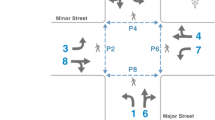Abstract
To effectively examine and properly response to the traffic congestion on the urban arterial, numerous traffic signal timing optimization programs have been introduced such as Synchro-6 and PASSER II-02. This study is aimed to provide the better insight into the basic difference between these two programs to traffic engineers or transportation practitioners by demonstratively comparing vehicle delay and bandwidth efficiency computed by two programs on the hypothetical arterial having five calibrated intersections spaced by 430-meter each other with varying traffic volume. This study concluded that difference in vehicle delay and bandwidth efficiency results from the characteristic of each program to optimize the traffic signal timing plan and to calculat ethe uniform delay, not from the used parameters (traffic volume). Further studies are requested to present more comprehensive characteristics of two programs to the traffic engineering group by comparing and evaluating them with the other factors that a ffect vehicle delay and bandwidth efficiency, such as intersection spacing, vehicle speeds, intersection capacity, and so on.
Similar content being viewed by others
References
Benekohal, R.F. and Elzohairy, Y.M. (2002). “A comparison of delay from HCS, Synchro, PASSER II, PASSER IV, and CORSIM for an urban arterial in America.”81st TRB Annual Meeting, Transportation Research Board, Washington, D.C.
Chang, E.C.P. and Messer, C.J. (1991).Arterial Signal Timing Optimization using PASSER II-90—Program User’s Manual, Texas Transportation Institute, College Station, TX.
Courage, K.G. (1973). “Computer graphics: a new look at signal progression in America.”ITE Journal, Institute of Transportation Engineers, Washington, D.C.
Highway Capacity Manual (2000).Special Report 209, Transportation Research Board, Washington D.C.
Husch, D. and Albeck, J. (2003).Synchro-6 user guide, Trafficware, Albany, CA.
Liu, C.C. (1988). “Bandwidth-constrained delay optimization for signal systems.”ITE Journal, Institute of Transportation Engineers, Washington, D.C.
Malakapalli, M.P. and Messer, C.J. (1993). “Enhancements to the PASSER II-90 Delay Estimation Procedures in America.”Transportation Research Record 1421. Transportation Research Board, Washington, D.C., pp. 94–103.
Mystkowski, C. and Khan, S (1999). “Estimating queue lengths using SIGNAL 94, SYNCHRO-3, TRANSYT-7F, PASSER II-90 and CORSIM in America.”78 th TRB Annual Meeting. Transportation Research Board, Washington, D.C.
Roess, R.P., McShane, W.R., and Prassas, E.S. (2003).Traffic Engineering, 3rd edition. Prentice-Hall, Upper Saddle River, NJ.
U.S. DOT Federal Highway Administration (2005). “Existing signal timing process.”http://ops.fhwa.dot.gov/traffic sig timing/sig tim proc/sect 2.htm. Accessed September 2005.
Author information
Authors and Affiliations
Rights and permissions
About this article
Cite this article
Kim, H.K., Oh, S.K. & Bae, GM. Demonstrative comparison of two traffic signal optimization programs: Synchro-6 and PASSER II. KSCE J Civ Eng 10, 41–45 (2006). https://doi.org/10.1007/BF02829302
Received:
Accepted:
Issue Date:
DOI: https://doi.org/10.1007/BF02829302




